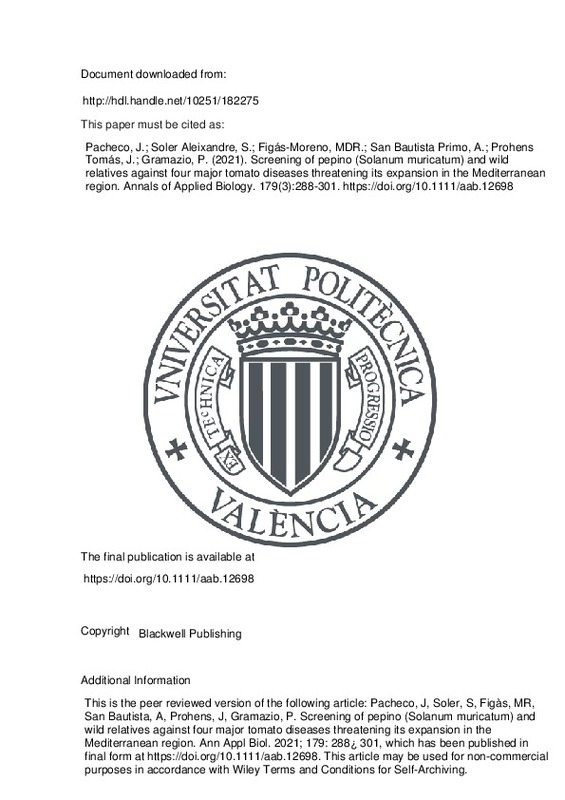|
Resumen:
|
[EN] The pepino (Solanum muricatum) is an Andean vegetable crop closely related to
tomato. In the last decades, it has been introduced in the Mediterranean region and
other parts of the world as a potential new crop. ...[+]
[EN] The pepino (Solanum muricatum) is an Andean vegetable crop closely related to
tomato. In the last decades, it has been introduced in the Mediterranean region and
other parts of the world as a potential new crop. However, several tomato major
pathogens may threaten the expansion of pepino cultivation. We identified Fusarium
oxysporum f. sp. lycopersici (FOL), Verticillium dahliae (VE), pepino mosaic virus
(PepMV) and tomato mosaic virus (ToMV) as four of the most likely pathogens to
cause damage to pepino crops in Mediterranean climates. In order to evaluate the
response of the pepino genepool against these pathogens, as well as to identify
sources of tolerance, we inoculated six accessions of cultivated pepino, nine accessions
of seven pepino wild relatives, and one interspecific hybrid with FOL, VE,
PepMV and ToMV and followed its symptomatology for 30 days (FOL and VE) or
60 days (PepMV and ToMV). ELISA tests were also performed for PepMV and ToMV.
Susceptible tomato materials were used as controls. The pepino genepool displayed
fewer symptoms than susceptible tomato controls after inoculation with FOL, with
most accessions being tolerant or resistant. Regarding VE, a wide variation of values
for the symptoms index (SI) was observed, with three cultivated pepino accessions
displaying tolerance. For PepMV a wide variation for SI was also observed, with one
accession of S. caripense being resistant, and several accessions of pepino and other
wild relatives displaying different degrees of tolerance. PepMV absorbance values
obtained by ELISA tests followed a pattern similar to that of SI. For ToMV no resistances
were found, although two wild accessions and the interspecific hybrid displayed
low values for the SI and were considered as moderately tolerant. ELISA tests
against ToMV revealed that the virus replicated well in all materials. None of the
accessions evaluated displayed resistance or high levels of tolerance to the four pathogens,
but some of them were complementary for resistance or high levels of toler-
ance. Although the interspecific hybrid tested was not resistant to any of the
pathogens, it was tolerant to FOL and PepMV and moderately tolerant to VE and
ToMV. A multivariate hierarchical clustering revealed similar patterns among accessions
in the response to the two fungal diseases (FOL and VE) on one side and to the
two viral ones (PepMV and ToMV) on the other. The information generated in this
study has allowed identifying materials within the pepino genepool for the development of multi-resistant pepino cultivars to major diseases threatening its
expansion in the Mediterranean region.
[-]
|
|
Descripción:
|
This is the peer reviewed version of the following article: Pacheco, J, Soler, S, Figàs, MR, San Bautista, A, Prohens, J, Gramazio, P. Screening of pepino (Solanum muricatum) and wild relatives against four major tomato diseases threatening its expansion in the Mediterranean region. Ann Appl Biol. 2021; 179: 288¿ 301, which has been published in final form at https://doi.org/10.1111/aab.12698. This article may be used for non-commercial purposes in accordance with Wiley Terms and Conditions for Self-Archiving.
|







![[Cerrado]](/themes/UPV/images/candado.png)


